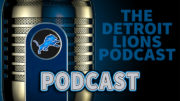In Part Two of the Around the NFL series, we explore why Matthew Stafford has struggled, and compare that to Josh Allen to see why he has found so much success in Buffalo in 2020.
In part one of this series, we explored why Saquon Barkley is being overhyped by the mainstream media. Then he got hurt. Hopefully the same doesn’t happen to this month’s topics, two starting quarterbacks in the form of Matthew Stafford for the Lions, and Josh Allen for the Buffalo Bills. Two quarterbacks who appear to be on opposite trajectories, at least through the first quarter of the 2020 NFL season.
Matthew Stafford has struggled, while Josh Allen has thrived so far this season. So then, it’s important to ask why? Stafford was entering this season as a QB getting top-five hype from not only local but even some national pundits. Josh Allen was thought of as a QB holding back the league’s top defense in 2019 from achieving great things.
The narratives on both quarterbacks have changed dramatically over the last month as we’ve seen a quarter of the season play out. This is where we come in. A quarter of the season isn’t the largest of sample sizes, however, there are a couple of key observations and notable trends with both quarterbacks that need to be addressed. Can Stafford right the ship and overcome his early struggles? Will Josh Allen regress to the mean? Those questions cannot currently be answered, but what can be looked at is why things have played out the way they have so far.
For now, we’re going to focus mainly on Matthew Stafford and his season with the Detroit Lions. Why has Stafford suddenly regressed? How much of the problem is on playcalling, wide receivers, or maybe the defense? Is Stafford the problem in Detroit, or is it the defense as the narrative has been presented? Time to dig deep and address some of these burning questions.
Matthew Stafford by Down
The first thing we’re going to take a look at is what downs Matthew Stafford has been the most successful and least successful in. Per ESPN’s splits, Stafford struggles the least on second downs of the three. He’s currently 27/43 for a completion percentage of 62.8%. He also hasn’t thrown an interception on second down yet, however, his yards per completion is by far the lowest of the three downs at only 5.9 compared to 8.2 and 8.3 on first and third. So what we can gather from this, is the Lions are passing short more frequently with success on second downs.
This happens as the team is trying to set up a shorter third down conversion, and is typically trying to play things a bit more safe, rather than take chances down the field. Plays like screens, drags, and other short-yardage plays have a higher chance of converting (more on this later, too) boosting Stafford’s completion percentage while lowering his yards per completion.
Meanwhile, one key problem for the offense so far has been first downs. This can, like many things we’ll explore over the course of this article, be traced back to Matthew Stafford’s struggles. Stafford is currently 31/53 on first downs, which comes in at 58.5% – his lowest. He also has thrown two interceptions on first downs, the highest of any down this season. The Lions, specifically Stafford, are taking more risks and chances on first down this year than they have in the past, and it’s led to some early-season struggles for Stafford.
Meanwhile, when it comes to keeping the offense on the field on third downs, he’s struggling a bit here, too. This year he’s at 22/37 (59.5%) on third downs, which means 15 drives have stalled on offense due to an incompletion on third down from Stafford and resulted in either a field goal, punt, or forced fourth down attempt. Last year, Stafford completed 64% of third downs, roughly 4.5% higher. In terms of completion percentage and a situation where every play matters, that is a significant number. Stafford was actually at his best on third downs last season with a 6-0 TD-INT rate, and a 116.3 QBR, an impressive number, especially when compared to his 2020 QBR on third downs of 93, over 20 points lower.
So what does this mean for the Lions offense? They’re putting themselves into difficult positions on second downs due to inconsistent play on first, and then failing to convert on third downs through the air compared to expectations for a Matthew Stafford-led offense.
Matthew Stafford by Quarter
So now that we know that Stafford is finding the most success on second down, we can take a look at his success by quarter. The correlation between downs and quarters may not have any causation, but there is some strange correlation here.
Stafford in the first quarter through four games in 2020 has been pretty mediocre. He has his highest QBR of all four quarters at a 108.1, despite only completing a really low 51.6% of his passes so far. Now, here is where things get interesting: Stafford’s first quarter last year was also his best, where he put up a whopping 72.7(!) percent completion rate. Over 20 points higher than this season. The drop off at the start of games has been incredibly dramatic, and it is part of why the Lions are starting slower this year than they did in 2019. Part of this can be attributed to rust to some degree, as practices in 2020 likely look very different than practices and the lead up to games did in 2019, however it is still such an incredibly dramatic difference that it deserves to be heavily scrutinized. Stafford was averaging 11.4 yards per attempt in the first quarter last year, compared to 7.4 in 2020, a difference of four yards per attempt.
On the other hand, the flip side is true of Stafford in the second quarter, particularly right before halftime. Stafford has looked incredibly sharp in quarter two, and it’s been a huge reason why the Lions are competitive and/or leading games going into the half. Against Chicago, the team outscored the Bears 10-3 in the second quarter and led 13-6 because of it. They outscored the Cardinals 14-6 in the second quarter and led 17-13 because of it. However, what’s interesting to note is that in the second quarter of the Saints and Packers games, the Lions were outscored by a combined 35-0. The defense struggled to get the ball back in Stafford’s hands in the second quarter, and the inability to finish drives has been a struggle for this team too (more on this later, also).
Coming out of halftime in the third quarter, Stafford is roughly average, and meets expectations but doesn’t really exceed them, surprise, or wow with his play. He’s currently posting a 62.5% completion rate and an 87.3 QBR in third quarters, which is about average and is not by any means bad or concerning. The reason for the dramatic drop in rating is that the average yards per attempt in the third quarter shrinks dramatically from 9 yards in the second (completing almost 70% of passes helps) to only 5.5 yards in the third, as the Lions come out of the break playing a much more conservative, ball-control style of offense in hopes of protecting the lead. Which typically works… Until the fourth quarter and the seemingly inevitable Lions collapse in 2020. Which leads us to the next topic.
Matthew Stafford Late in Games
Matthew Stafford is a relatively average quarterback this year through three quarters. A bit below average in the first in terms of completions, a bit below average in the third in terms of yards per completion, but makes up for both with his play in the second quarter of games, where he’s shone.
Now, it’s time to address fourth quarter Matthew Stafford. Now, before I get too far into this, a note from the author is you can feel free to blame this on whoever you deem fit. This is not just a Matthew Stafford problem, and he is not solely responsible for what you are about to see. Part of the blame for this, like the other sections including the one after this, goes to his wide receivers not getting open, the playcalling late in games, and the inability to also run the ball consistently to help chew the clock. With that in mind, time to address Stafford here.
Stafford in the fourth quarter of games this season is currently posting his lowest QBR of all four quarters, at 79.3. His completion percentage is below average at 58.7, which is not quite as bad as his first quarter, but far below expectations, and what he does in the middle of games. Why is his QBR so much lower, then? First, he is taking way more sacks in the fourth quarter than any other. Seven of the 12 sacks Stafford has taken this year have occurred in fourth quarters, leading to long down and distances, needing to take chances, and of course, are part of why the Lions aren’t able to stick to the run in the fourth quarter and close out games after a sack. Additionally, Stafford only has one touchdown in the fourth quarter this year, and one interception. That’s the least amount of touchdowns he’s thrown in any quarter this season.
So those numbers are pretty disappointing, however, it gets even worse. When taking a look at every passing attempt starting with attempt number 31 until the end of the game per NFL Situational Stats, Stafford is a whopping 8/17 to close out games. That’s a completion percentage of 47.1. He also has a 0-1 TD-INT rate in these situations, which leads to an absurdly unheard of QBR of 46.4! Stafford’s inability to put the team on his back this season has taken a dramatic hit very, very quickly. He went from being one of the best fourth-quarter quarterbacks in the league to suddenly being a dramatic negative in the fourth quarter of games. It’s an incredibly sharp and dramatic regression that nobody could’ve seen coming. How much of the blame is on him is up for debate. Is it his injury holding him back late in games? The offensive system worked last year – has Offensive Coordinator Darrell Bevell changed the system so much in a shortened offseason that Stafford all of a sudden is terrible in the fourth quarter due to playcalling or system?
There is one culprit for this that is very interesting, however, and it isn’t isolated to just the fourth quarter. It’s not that Stafford’s comeback prowess has gone away suddenly, it’s Stafford’s passing ability when playing with a lead. When behind and tied, Stafford is completing 64% of his passes, with average yards per attempt of 7.3 when behind and 10.7 when tied. This leads to an incredibly impressive 100.1 QBR when behind, and 97.5 QBR when tied (touchdown numbers are responsible for the difference, here).
However, when Stafford is playing with a lead, he is suddenly much, much worse. His completion percentage drops to 51.4%, an absolutely ridiculously low number and with it, his yards per attempt drops to a crazy low 4.5.
Stafford’s inability to pass at all consistently with a lead allows teams to crash down in the box and defend the run in a significant way, preventing the Lions from chewing clock and finishing off games, one of the team’s biggest issues this season.
Matthew Stafford in the Red Zone:
We just went over Stafford’s inability to close out games so far in 2020 and his struggles in the fourth quarter, however, the offense’s inability to finish isn’t the only hindrance. The issue also extends to drives, specifically in the red zone.
So we come back to Matthew Stafford again, and we find that here, too, the Lions offense struggles have a direct correlation to the struggles of Stafford. Stafford in the red zone this year has a completion percentage of 43.5%. Now granted his QBR is inflated due to a 7-1 TD-INT ratio as only one of his 13 incompletions has been a turnover while 7/10 of his completions have resulted in touchdowns, but even that is at a relatively low 72.3. Why might this be the case?
Stafford has really struggled when there has been a tight end on the field. When the Lions have at least one tight end on the field, Stafford is currently 52/94, which is a 55% completion rate with a 3-3 TD-INT ratio, has taken 9/12 sacks so far, and has a QBR of 83.5 with one tight end, and 55.1 with two tight ends. When the team has neither TJ Hockenson nor Jesse James on the field, however, Stafford is absolutely remarkable, posting a 71.8% completion rate, 4-0 TD-INT rate, and a 127.8 QBR. The numbers are very similar with running backs as well.
Stafford is thriving with multiple receivers on the field, yet when the team puts running backs or tight ends on the field, all of a sudden he starts to get worse, increasingly so the more receivers you take off. When the team goes for heavier, more powerful sets in the red zone, specifically the inclusion of TJ Hockenson and or Jesse James, Stafford struggles, and the same goes for running backs Kerryon Johnson, D’Andre Swift, and Adrian Peterson. So one possibility to correct this is to try using empty sets in the red zone, or maybe with a lead. While Hockenson and Swift most certainly have their place, Stafford seems to be struggling right now with those two on the field, which is quite disappointing, and yet another thing the Lions will need to bank on improving to see offensive progression to the mean this season.
Another reason Stafford could be seeing some regression in the red zone is his inability to convert on plays between 15 and 30 yards this season. Next Gen Stats, which tracks every throw’s distance and location across the NFL, has Stafford’s charts up of all his passes through the first four weeks. I went through and counted all the throws between 15-30 yards so far this season, and discovered that on throws in that range, Stafford is currently 10/26, which is roughly 38.5%. If you exclude the Bears game from that and look at the last three, he is currently 5/17 when throwing between 15-30 yards past the line of scrimmage. This translates to a 29.4% completion percentage. When Stafford isn’t hitting intermediate throws, specifically in the red zone or on third downs, and even worse potentially late in games or when needing to come back, it’s a recipe for failure.
Part of this goes to playcalling too, as well as the pass-catchers and offensive line. Attempting less than two passes per quarter between 15 and 30 yards downfield is definitely less than ideal in 2020. Some of that may be due to protecting Stafford from sacks, part of it may be receivers not getting open downfield, part of it may be his back, but whatever the reason, it has still been a problem spot for the Lions this season. It also doesn’t help that Stafford is a combined 0/5 on passes beyond 30 yards downfield, going 0/2 vs the Bears and 0/3 vs the Saints, which would bring his percentages on all passes of 15 yards or more downfield to 10/31 (32.3%) and excluding the throws between 15-30 against the Bears, a whopping 5/22 or 22.7% completion rate on all throws 15+ yards downfield. A dramatic shift from the Stafford we saw in 2019.
Is Matthew Stafford to blame for the Lions losing?
Exclusively or solely, the answer to that is no, he is not the only reason the Lions are losing games. However, the struggles noted above on Stafford so far this season are certainly a cause for concern. If he doesn’t rebound quickly, especially against an upcoming letdown in quality of opponent over the second and third quarters of the season, the Lions and their fans will be in for a lot of disappointment, including a likely regime change at the end of the season that would almost certainly see the departure of Stafford along with it.
Ultimately, that is a worst-case scenario though, too. It is entirely possible that rather than rust from the back injury and a long term issue, this is a short term issue caused by the shortened offseason due to the global virus pandemic plaguing the world this season. Week 5 this year is normally Week 1 in a regular NFL season, and it’s possible Stafford has just been in preseason form. While other quarterbacks around the league have found success this year, specifically Josh Allen who we will take a look at in part two of the second edition of this series, it’s still early enough in the season that he has time to rebound and continue to get better as the season progresses, but it’s got to happen quickly if the Lions are going to save their season.
Thanks for reading! Hopefully, you learned a thing or two along the way. Don’t forget to follow @C_Robbins_ on Twitter, and leave me your thoughts on the Detroit Lions Subreddit! Check out some of Chris’s other articles for the Detroit Lions Podcast here.


